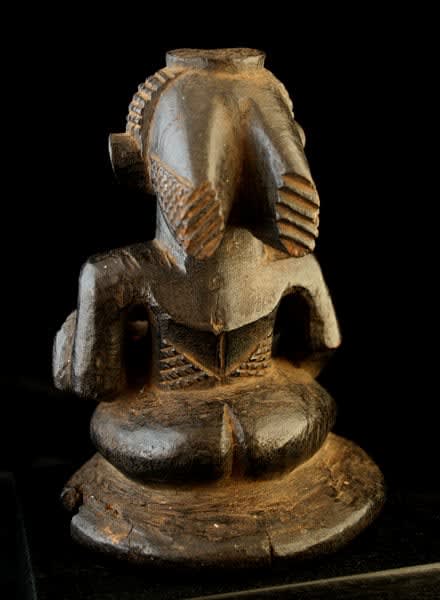Luba Wooden Maternity Sculpture, 20th Century CE
Wood
11.4 x 16.8 cm
4 1/2 x 6 5/8 in
4 1/2 x 6 5/8 in
CK.0029 (LSO)
Further images
This serene figure is an mboko sculpture from the Luba tribe of Gabon and what was once Zaire. Portraying a sitting woman with crossed legs holding a child on her...
This serene figure is an mboko sculpture from the Luba tribe of Gabon and what was once Zaire. Portraying a sitting woman with crossed legs holding a child on her knee, this is a classic piece of Luba artwork, with a high neck, a small head, a serene face with fine detailing, and a more reductivist body with some detailing to the upper chest, arms and the child itself. The coiffure and sides of the abdomen are detailed with fine hatching which combines with the deep patina to make this a superb example of the genre.
The Luba people were once the major power in this region, with over a million people paying tribute to the descendants of King Kongolo Maniema (who founded the dynasty in 1585). Their wealth, which came from fishing and metalworking, made them ferocious traders across West Africa and as far as the Indian Ocean. They were seriously impacted upon by slaving missions and the rise of the Ovimbudu people of Angola, and were subsumed into the Belgian Empire in the early 20th century. They are very closely related to the immediately proximate Hemba people, especially in art terms.
They were governed by a divine king (Mulopwe) and a set of social notables who were collectively known as Bamfumus. The Balopwe or “clan kings” governed designated areas as symbolic sons of the Mulopwe. Social harmony and memory was controlled through the Bambudye (or Mbudye) secret society; aristocratic status is attained by the ability to trace one’s lineage to a founding member of the Luba people. The king lists are especially important, as the divine status of rulers has had a notable effect on the arts and crafts of the Luba empire.
The Luba are renowned for their figures and anthropomorphic shrine paraphernalia; carvers display incredible flexibility in terms of their representation techniques, some of which are so distinctive that pieces can be attributed to individual artists (such as the Master of Buli, one of the few historically-recognised indigenous carvers). Mboko are divination pieces, and show a kneeling or seated woman, sometimes holding a receptacle. Mwadi – female incarnations of ancient kings – are a common characteristic of Luba art, and women also play key roles in Luba creation myths, being strongly associated with divination (Katatora) and prestige paraphernalia. There are three main carving styles – Mwanza, Upemba and Mitwaba; the current piece is carved in the former, meaning that it originates in the north of the Luba territory, along the Lualaba River.
Judging from its size, this piece would have been a domestic item. It represents an ancestor, though not necessarily a female one. It has acquired a solid, glossy patina from considerable handling, and is a beautifully serene and attractive piece of African art.
The Luba people were once the major power in this region, with over a million people paying tribute to the descendants of King Kongolo Maniema (who founded the dynasty in 1585). Their wealth, which came from fishing and metalworking, made them ferocious traders across West Africa and as far as the Indian Ocean. They were seriously impacted upon by slaving missions and the rise of the Ovimbudu people of Angola, and were subsumed into the Belgian Empire in the early 20th century. They are very closely related to the immediately proximate Hemba people, especially in art terms.
They were governed by a divine king (Mulopwe) and a set of social notables who were collectively known as Bamfumus. The Balopwe or “clan kings” governed designated areas as symbolic sons of the Mulopwe. Social harmony and memory was controlled through the Bambudye (or Mbudye) secret society; aristocratic status is attained by the ability to trace one’s lineage to a founding member of the Luba people. The king lists are especially important, as the divine status of rulers has had a notable effect on the arts and crafts of the Luba empire.
The Luba are renowned for their figures and anthropomorphic shrine paraphernalia; carvers display incredible flexibility in terms of their representation techniques, some of which are so distinctive that pieces can be attributed to individual artists (such as the Master of Buli, one of the few historically-recognised indigenous carvers). Mboko are divination pieces, and show a kneeling or seated woman, sometimes holding a receptacle. Mwadi – female incarnations of ancient kings – are a common characteristic of Luba art, and women also play key roles in Luba creation myths, being strongly associated with divination (Katatora) and prestige paraphernalia. There are three main carving styles – Mwanza, Upemba and Mitwaba; the current piece is carved in the former, meaning that it originates in the north of the Luba territory, along the Lualaba River.
Judging from its size, this piece would have been a domestic item. It represents an ancestor, though not necessarily a female one. It has acquired a solid, glossy patina from considerable handling, and is a beautifully serene and attractive piece of African art.







